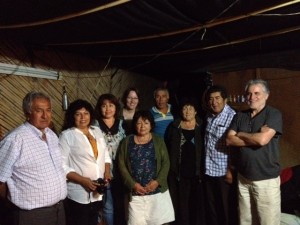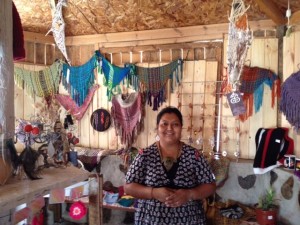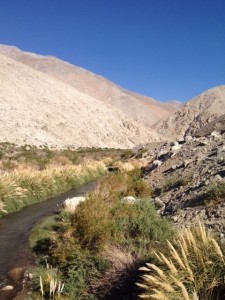Adrienne Wiebe is an MCC Alberta staff member. A trained anthropologist, Adrienne summarizes the findings of a longer report she undertook forMiningWatch Canada and the Latin American Observatory of Environmental Conflicts (Observatorio Latinoamericano de Conflictos Ambientales or OLCA) on the impacts of the company Barrick Gold. While Mennonite Central Committee does not have a program in Chile, it is important to highlight the activities of Barrick Gold, as the company operates throughout the Americas. This article was originally posted on the MCC Ottawa Office Notebook.
In March of this year, I visited the beautiful Huasco River valley in the Andes Mountains in northern Chile to learn about the impact of a gold mine on the local people and their valley. The mine is operated by Toronto-based Barrick Gold, the largest gold mining company in the world. Straddling the height of the Andes Mountains between Chile and Argentina, thePascua-Lama site boasts one of the largest reserves of gold and silver ever discovered – an estimated 15.4 million ounces of gold and 675 million ounces of silver.
The mine has been plagued with challenges and controversy since construction began in the late 1990s. Of primary concern has been the negative environmental impact of the project, particularly given the location of mineral reserves underneath and near glaciers that are part of a watershed that serves this fragile but fertile valley. The small glacier-fed river in the valley enables small-scale irrigation and cultivation of food crops and vineyards. Threats to the supply and quality of the water have been the primary concern. Several times over the last 15 years, operations have been halted because of environmental violations. A denunciation by local community groups was accepted by the Inter-American Human Rights Commission in 2009.
Indigenous peoples and social license

A meeting with Diaguita community leaders in the Huasco Valley, Chile to talk about the impact of the Pascua-Lama mine. Photo by Adrienne Wiebe.
Given the generally negative local perception of the mine, Barrick has been focusing in the past ten years on gaining the support of the local Indigenous population. These are people who identify as Diaguita, the traditional Indigenous people in the area, and who represent about half of the current area population. However, until 2006, the Diaguita were not an official “ancestral people” recognized by the Chilean government.
Barrick was involved from the beginning in the process of what the company called “rescuing” Diaguita culture. The company funded cultural classes and documentation and application for Indigenous status for residents. It was also involved in the formation of Indigenous state-recognized community groups.
In May 2014, the company signed a Memorandum of Understanding (MOU) with 15 Diaguita communities that it helped to form. According to Barrick Gold officials, the agreements met the requirements of international guidelines of the rights of Indigenous peoples to consultation, participation, and to set their own development priorities as laid out by the international Indigenous and Tribal Peoples Convention, (International Labour Organization ILO – No. 169). Barrick felt that this MOU set a new standard for mining companies around the world in their relationships with local Indigenous communities.
A problematic process

Palinay, a Diaguita community member, impacted by Barrick’s Pascua Lama gold mine in the Andes Mountains of Chile. Photo by Adrienne Wiebe.
However, local community members presented a different story. Palinay, a Diaguita artisan, objects to the commodification and exploitation of her Indigenous identity:
“We dress up for ceremonies and photos when we sign agreements. We are learning the Quechua language, the language of the Inca Empire, not the local language, because [Barrick brought] someone from the Quechua area who came to teach ceramics and taught people some Quechua words. Those people signing the MOU are a caricature of our culture. Barrick is using Indigenous status to legitimize its presence. We need to make an effort to guard our authentic culture, preserve it, and transmit it to our children.”
Jhon Meléndez, a Diaguita and a spokesperson for the Coalition for Water of Huasco Alto (Asamblea del Agua del Huasco Alto), is a member of a small Diaguita community which was one of the groups that did not sign the MOU with Barrick:
“Although we have lost a lot of our culture, we maintain our traditions. We are not ‘rescuing’ our Indigenous identity, like Barrick says; rather we are ‘preserving’ our identity.”
For many of the local people, Barrick Gold was in a conflict of interest when it utilized its immense resources to finance the registration of Indigenous identity, form government-recognized Indigenous communities, and then sign agreements with these groups.
The result: social conflict
According to the community members I spoke with, the development and approval of the MOU was a confusing process, which lacked transparency, and created social conflict and division. Barrick Gold provided handouts of money to community groups that resulted in accusations of mismanagement, bribery, and cronyism. Because of the conflicts, today there are two or three Indigenous organizations in communities where previously only one existed.
Since 2013, mining operations at Pascua-Lama have been suspended because of environmental and regulatory compliance issues. In early September 2015, an indefinite halt of operations was announced because of escalating costs (the project has cost more than $5 billion to date), the declining price of gold on the international markets (a price of $1,500 per ounce is needed to make the project feasible), and share-holder dis-satisfaction with performance.
However, while mining operations may have halted for now, the Pascua-Lama mining project has done enduring damage to the social fabric of the valley.
Read the full report published by MiningWatch Canada and OLCA (Observatorio Latinoamericano de Conflictos Ambientales).

